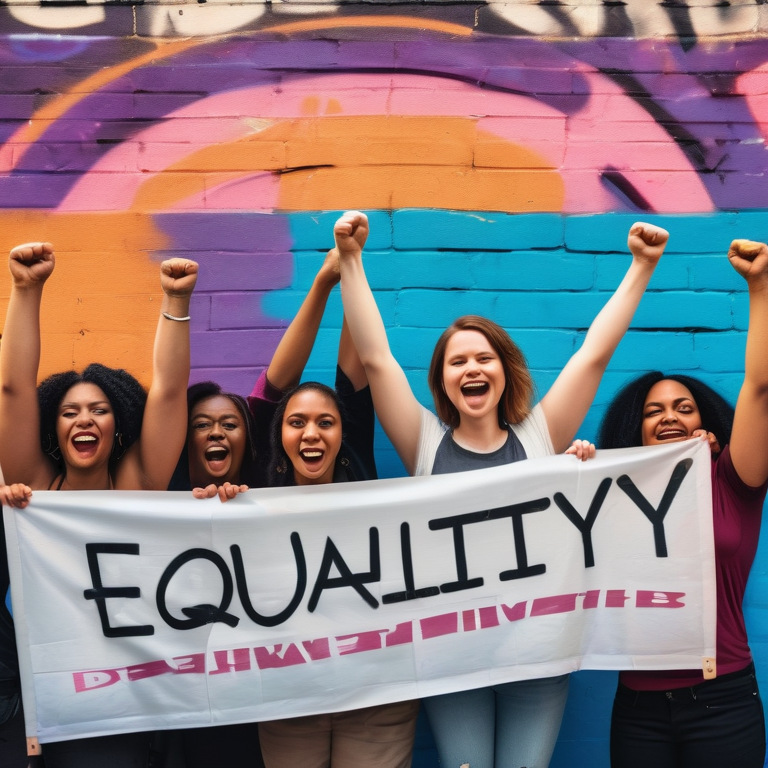Exploring Third-Wave Feminism and Sexual Diversity

Key Highlights
- The third wave of feminism emerged in the 1990s and focused on expanding civil rights and social equality for women.
- It was led by Generation Xers who critiqued and built upon the work of previous feminist movements.
- Third-wave feminism celebrated diversity, intersectionality, and sexual liberation.
- Key issues included intersectionality, reproductive rights, individual empowerment, violence against women, and sexual liberation.
- The third wave had a significant impact on popular culture, media representation, and the fight for LGBTQ+ rights.
- The fourth wave of feminism emerged around 2012, focusing on issues such as sexual harassment, body shaming, and rape culture.
Introduction
Feminism has gone through several waves of change and evolution throughout history, each wave building upon the progress made by the previous one. One of the most significant waves is the third wave of feminism, which emerged in the 1990s and continues to shape the feminist movement today. This wave, also known as third wave feminism, is characterized by its focus on expanding civil rights and social equality for women, with a specific emphasis on intersectionality and sexual diversity. This period of feminism was marked by a surge of political activism, utilizing social media and other platforms to advocate for women’s rights and challenge societal norms.
The third wave of feminism was led by Generation Xers, individuals born in the 1960s and 1970s, who grew up in a society marked by cultural diversity and media saturation. These young feminists recognized the progress made by previous waves of feminism but also acknowledged the work that still needed to be done. They critiqued and built upon the foundations laid by their predecessors, seeking to bring about change in a more inclusive and intersectional manner. This generation, known as Generation X, played a crucial role in shaping the third wave of feminism through their activism and the massive expansion of opportunities for disseminating feminist ideas through the information revolution of the late 20th century. Additionally, they were able to utilize their greater economic and professional power and status achieved by women of the second wave. This generation also saw the coming of age of Generation X scholars and activists, further contributing to the massive expansion of the third wave of feminism and promoting sexual diversity.
This blog will explore the key highlights, history, principles, challenges, and impact of third-wave feminism. It will delve into the roots of the movement, the transition from the second wave, and the core principles that define third-wave feminism. Additionally, it will examine how third-wave feminism embraces sexual diversity and identity, the concept of intersectionality, and its role in expanding feminism’s reach. The blog will also highlight key movements, prominent figures, and challenges faced by third-wave feminism. Moreover, it will discuss the relationship between third-wave feminism and popular culture, as well as its global perspectives and future directions.
The Evolution of Feminism: Understanding its Waves
Feminism has evolved over time, with each wave representing a distinct period of feminist activism. The first wave, known as the suffragette movement, focused on achieving political equality for women. This marked the West’s first sustained political movement dedicated to women’s rights. The second wave addressed gender-based discrimination and sexual liberation. The third wave of feminism emerged in the 1990s, building upon the achievements of the previous waves and advocating for intersectionality, sexual diversity, and social justice. Understanding the evolution of feminism, from a political movement to a more inclusive and diverse movement, is crucial to comprehending the significance of the third wave and its impact on society.
The Roots of Third-Wave Feminism
The roots of third-wave feminism can be traced back to the early 1990s when Rebecca Walker, daughter of writer and activist Alice Walker, coined the term in her article “Becoming the Third Wave.” This article responded to the Anita Hill Senate hearings in 1991, where Hill testified against Clarence Thomas, a Supreme Court nominee, for sexual harassment. The prominence of these hearings marked a new era of activism and ferment among the early adherents of the new approach, seeking to dismantle gender exploitation and prejudice through organizations like the Third Wave Foundation.
Another influential catalyst for the third-wave feminist movement was the riot grrrl punk movement that emerged in Olympia, Washington. This underground subculture of young feminists focused on punk rock music, politics, and sex positivity. Third-wave feminism sought to reclaim femininity and female sexuality, challenging societal norms and advocating for gender equality through grassroots activism.
Rebecca Walker’s article and the riot grrrl movement were instrumental in shaping the ideology and values of third-wave feminism, placing emphasis on the intersectionality of feminism and the experiences of women of color. These foundational roots continue to influence the movement today.
Transition from Second to Third Wave
The transition from the second wave to the third wave of feminism marked a shift in focus from legal and political equality to a broader emphasis on cultural and social change. The second wave of feminism, which gained momentum in the 1960s and 1970s, addressed gender-based discrimination and worked towards legal reforms and reproductive rights. However, the third wave, while still benefiting from the legal rights and protections obtained by their predecessors, also inherited a foothold of institutional power from the second wave, including women’s studies programs, feminist organizations, and established publishing outlets. This foothold played a crucial role in the manifestations of the third wave, which expanded beyond the traditional focus on legal and political equality.
One of the pivotal moments in this transition was the Anita Hill Senate hearings in 1991. Hill accused Clarence Thomas, a Supreme Court nominee, of sexual harassment. Although Thomas was confirmed despite her allegations, the hearings sparked a renewed sense of activism and a push for greater gender equality.
The third wave also drew inspiration from the riot grrrl movement, a subculture of young feminists who used punk rock music and DIY aesthetics to promote self-expression and challenge societal norms. This movement played a significant role in shaping the cultural landscape of the 1990s and contributed to the feminist activism of the third wave.
The transition from the second wave to the third wave marked a shift towards a more inclusive and intersectional feminism that embraced diversity, sexuality, and gender identities.
Core Principles of Third-Wave Feminism
The core principles of third-wave feminism, also known as third wavers, revolve around the feminist movement’s commitment to gender equality, intersectionality, and social justice. Unlike previous waves, third-wave feminism recognizes the importance of inclusive feminism that addresses the experiences and struggles of all individuals, including black women, regardless of race, class, or sexual orientation. It acknowledges the intersecting oppressions faced by marginalized groups and seeks to dismantle systems of power and privilege. Third-wave feminism also places a strong emphasis on sexual liberation and the celebration of diverse expressions of femininity.
Embracing Sexual Diversity and Identity
One of the key aspects of third-wave feminism is its emphasis on embracing sexual diversity and identity. This wave of feminism recognizes that gender is not binary and embraces the full spectrum of gender identities and expressions. It seeks to create a more inclusive society where individuals can freely express their sexuality and gender without fear of discrimination or prejudice, making it the movement’s greatest strength. By embracing multivocality and diversity, third-wave feminism challenges traditional notions of feminism and creates a more inclusive and empowering movement.
Some key points regarding the embrace of sexual diversity and identity within third-wave feminism are:
- Recognition and celebration of diverse sexual orientations and gender identities.
- Advocacy for LGBTQ+ rights and equal treatment under the law.
- Challenging societal norms and stereotypes surrounding sexuality and gender.
- Supporting individuals in their journey of self-discovery and self-acceptance.
- Fighting against discrimination and violence faced by marginalized sexual and gender communities.
By embracing sexual diversity and identity, third-wave feminism aims to create a more inclusive and equitable society for all individuals, regardless of their sexual orientation or gender identity.
Intersectionality and Expanding Feminism’s Reach
Intersectionality is a central concept in third-wave feminism, highlighting the interconnected nature of oppression and the need to address multiple forms of discrimination. Third-wave feminists recognize that gender inequality cannot be fully understood or addressed without considering other intersecting factors such as race, class, sexuality, and ability.
Expanding feminism’s reach to include intersectionality broadens the movement’s focus and ensures that the experiences and struggles of marginalized groups are not overlooked. This intersectional approach allows for a more nuanced understanding of power dynamics and seeks to dismantle systems of oppression that affect individuals differently based on their intersecting identities.
By embracing intersectionality, third-wave feminists aim to create a more inclusive feminist movement that challenges all forms of discrimination and works towards a more equitable society for all.
Third-Wave Feminism in Action
Third-wave feminism is not just a theoretical concept; it is a lived reality and a call to action. It has manifested in various forms of feminist activism, from grassroots movements to political campaigns. This section will explore how third-wave feminism has been put into action and the key movements and moments that have shaped its trajectory.
Key Movements and Moments
The third wave of feminism has been marked by significant movements and moments that have shaped its trajectory and impact. Some key movements and moments include:
- Riot Grrrl movement: Emerging in the 1990s, the riot grrrl movement combined feminist activism with punk rock music, promoting self-expression, empowerment, and challenging societal norms.
- Year of the Woman: In 1992, a record number of women were elected to the US Congress, marking a significant moment in the feminist movement and political representation.
- Vagina Monologues: Eve Ensler’s play, “The Vagina Monologues,” premiered in New York in 1996, sparking discussions about women’s sexuality, empowerment, and experiences.
- Feminist activism in the digital age: The rise of social media and online platforms has allowed for greater visibility and connectivity within the feminist movement, leading to viral campaigns such as #MeToo and #TimesUp.
These movements and moments have played a crucial role in shaping the feminist landscape, raising awareness, and mobilizing individuals to fight for gender equality.
Prominent Figures and Their Contributions
Prominent figures have played a significant role in advancing third-wave feminism and pushing for social change. Some key figures and their contributions include:
- Gloria Steinem: A prominent feminist leader, writer, and activist, Steinem has been a key advocate for gender equality and reproductive rights.
- Judith Butler: A feminist philosopher and scholar, Butler’s work on gender performativity has been influential in challenging traditional notions of gender and sexuality.
- Rebecca Walker: As the daughter of Alice Walker, Rebecca Walker coined the term “third wave” and has been instrumental in shaping the ideology and direction of the movement.
These figures, among many others, have contributed to the intellectual and cultural foundations of third-wave feminism, amplifying marginalized voices and advocating for social justice.
Challenges Within Third-Wave Feminism
While third-wave feminism has made significant strides in advancing gender equality and promoting inclusivity, it has faced its fair share of challenges. This section will explore some of the critiques and debates surrounding third-wave feminism, highlighting the complexities and ongoing struggles within the movement.
Critiques of Inclusivity and Intersectionality
One of the main critiques of third-wave feminism is the ongoing debate around its inclusivity and intersectionality. Critics argue that certain voices and perspectives are still marginalized within the movement, particularly those of women of color, transgender individuals, and individuals from lower socioeconomic backgrounds. The challenge lies in ensuring that intersectionality is not just a theoretical concept, but a lived reality within feminism.
Intersectional feminism recognizes that various forms of oppression intersect and compound, and that true equality cannot be achieved without addressing these intersecting factors. It is essential for third-wave feminists to actively engage with and uplift diverse voices, challenge power dynamics, and work towards an inclusive movement that centers the experiences and needs of all individuals.
The Debate Over Feminist Identity
Another ongoing debate within third-wave feminism revolves around the concept of feminist identity. Some argue that the movement has become fragmented and diluted, making it challenging to define a singular feminist identity. This debate encompasses discussions around the inclusivity of men within feminism, different feminist theories and perspectives, and the role of feminism in addressing the needs and experiences of all individuals, including those within the LGBTQ+ community and those studied in gender studies.
While this debate reflects the complexities and diversity within the movement, it also highlights the need for ongoing dialogue and critical reflection within third-wave feminism. By engaging in these debates, feminists continue to shape and refine the movement, ensuring that it remains relevant and responsive to the evolving needs of women and marginalized communities.
Sexual Diversity and Third-Wave Feminism
Sexual diversity is a central focus of third-wave feminism, challenging societal norms and celebrating the full spectrum of sexual orientations and gender identities. This section will explore the intersection of sexual diversity and third-wave feminism, discussing the impact of feminist activism on LGBTQ+ rights and the fight against discrimination based on sexual orientation. This includes the influence of queer theory, which has played a major role in the development of third-wave feminist theories and practices.
Breaking Down Barriers in Gender and Sexuality
One of the key contributions of third-wave feminism has been its efforts to break down barriers in gender and sexuality. This wave of feminism challenges the binary understanding of gender and recognizes the complexities and diversity within sexual orientations and gender identities.
Third-wave feminists actively work towards creating a society where individuals can freely express their true selves, regardless of societal expectations or norms. This includes challenging stereotypes, fighting against discrimination and violence towards LGBTQ+ individuals, and advocating for equal rights and opportunities for all.
By embracing sexual diversity and promoting inclusivity, third-wave feminism aims to create a more equitable and accepting society for individuals of all sexual orientations and gender identities.
The Role of Third-Wave Feminism in LGBTQ+ Rights
Third-wave feminism has played a pivotal role in the fight for LGBTQ+ rights, advocating for equality, inclusivity, and social justice. Some key contributions of third-wave feminism in the realm of LGBTQ+ rights include:
- Advocacy for equal rights: Third-wave feminists have been at the forefront of advocating for equal rights and legal protections for LGBTQ+ individuals, including marriage equality, adoption rights, and employment non-discrimination.
- Challenging heteronormativity: Third-wave feminism challenges heteronormative ideals and promotes inclusivity and acceptance of diverse sexual orientations and gender identities.
- Intersectionality: Third-wave feminism recognizes the importance of intersectionality and the overlapping systems of oppression faced by LGBTQ+ individuals, particularly those from marginalized communities.
By fighting for LGBTQ+ rights, third-wave feminism continues to contribute to the ongoing struggle for equality and acceptance for all individuals, regardless of their sexual orientation or gender identity.
|
Column Name A |
Column Name B |
|
Advocacy for equal rights |
Third-wave feminists have been at the forefront of advocating for equal rights and legal protections for LGBTQ+ individuals, including marriage equality, adoption rights, and employment non-discrimination. |
|
Challenging heteronormativity |
Third-wave feminism challenges heteronormative ideals and promotes inclusivity and acceptance of diverse sexual orientations and gender identities. |
|
Intersectionality |
Third-wave feminism recognizes the importance of intersectionality and the overlapping systems of oppression faced by LGBTQ+ individuals, particularly those from marginalized communities. |
Third-Wave Feminism and Popular Culture
Third-wave feminism has had a significant impact on popular culture, shaping media representation and influencing societal attitudes towards gender roles and empowerment. This section will explore the relationship between third-wave feminism and popular culture, discussing its influence on music, fashion, literature, and media representation.
Media Representation and Influence
Media representation is a crucial aspect of third-wave feminism’s impact on popular culture. Third-wave feminists have challenged traditional gender roles and stereotypes through various forms of media, including television shows, films, and literature. This has led to greater visibility and diverse representation of women in the media.
Third-wave feminists have also utilized social media platforms to amplify their voices and challenge societal norms. Online activism and the use of hashtags, such as #MeToo and #TimesUp, have sparked global conversations about gender equality and led to concrete changes within industries.
Additionally, third-wave feminism has influenced the fashion industry, promoting body positivity, inclusivity, and self-expression. The rise of the riot grrrl movement and its punk rock aesthetics, as well as the concept of “girl power,” have shaped trends and empowered individuals to embrace their unique styles and identities.
By influencing media representation and popular culture, third-wave feminism has brought greater visibility to feminist ideals, challenging societal norms and inspiring individuals to question and redefine traditional gender roles.
Impact on Music, Fashion, and Literature
Third-wave feminism has left a lasting impact on music, fashion, and literature, shaping trends and challenging societal norms. In music, feminist voices have emerged, addressing issues such as gender inequality, violence against women, and the female experience. The riot grrrl movement, with bands like Bikini Kill and Sleater-Kinney, used punk rock music as a platform for feminist activism, empowering women and challenging the male-dominated music industry. The Guerrilla Girls, a group of feminist artists, also played a crucial role in the evolution of the Riot Grrrl Movement, setting the foundation for radical feminist revolt and disrupting the status quo in the art world.
In the realm of fashion, third-wave feminism has promoted body positivity, inclusivity, and self-expression. The concept of “girl power” has influenced fashion trends, encouraging women to embrace their unique styles and challenge traditional gender norms.
Literature has also been impacted by third-wave feminism, with books like “The Vagina Monologues” by Eve Ensler exploring women’s sexuality, empowerment, and experiences. These literary works have provided a platform for women to share their stories and challenge societal perceptions.
Through music, fashion, and literature, third-wave feminism has contributed to a more inclusive and empowering popular culture, inspiring individuals to embrace their identities and challenge prevailing norms.
Global Perspectives on Third-Wave Feminism
While third-wave feminism has its roots in the United States, it has gained momentum and influence worldwide. This section will explore the global perspectives on third-wave feminism, highlighting the cultural differences and challenges faced by the movement in different parts of the world.
Similarities and Differences Across Cultures
Third-wave feminism is not a monolithic movement, and its manifestations vary across different cultures and societies. While the core principles of gender equality and social justice are universal, the specific challenges and priorities of third-wave feminism may differ based on cultural contexts.
Cultural differences play a significant role in shaping the feminist movement, influencing the strategies, goals, and methods employed by feminists in different regions. The struggles and achievements of women of color, for example, may be distinct from those of white women in Western societies.
Despite the differences, there are also similarities and common goals across cultures. The fight against gender-based discrimination, violence against women, and the pursuit of reproductive rights are shared concerns that transcend borders.
Understanding the cultural differences and similarities within third-wave feminism is crucial for building global solidarity and creating meaningful change across diverse societies.
Case Studies: Third-Wave Feminism Worldwide
Examining case studies from different regions provides insight into the complexities and challenges faced by third-wave feminism worldwide. Some case studies that highlight the global perspectives of third-wave feminism include:
- Latin America: Feminist movements in countries like Argentina and Chile have fought for reproductive rights, gender equality, and an end to violence against women.
- Middle East: Feminist activists in countries like Iran and Saudi Arabia have been at the forefront of challenging patriarchal norms and advocating for women’s rights.
- Africa: Women-led movements in countries like Nigeria and South Africa have addressed issues such as child marriage, female genital mutilation, and gender-based violence.
- Asia: Feminist activism in countries like India and Japan has focused on addressing deep-rooted gender inequalities, including workplace discrimination and social expectations.
These case studies illustrate the diverse challenges and achievements of third-wave feminism across different regions, highlighting the importance of localized approaches in achieving gender equality and social justice.
The Future of Third-Wave Feminism
The future of third-wave feminism holds both promise and ongoing challenges. This section will explore emerging trends and directions within the movement, as well as the continuing struggle for equality and inclusivity.
Emerging Trends and Directions
As third-wave feminism continues to evolve, new trends and directions are emerging that shape its trajectory. Some of these emerging trends include:
- Fourth wave of feminism: Some argue that a fourth wave of feminism has already begun, with a focus on online activism, social media, and the fight against online harassment and misogyny.
- Social media and information revolution: The rise of social media has revolutionized feminist activism, providing a platform for marginalized voices and enabling global conversations about gender equality.
- Continued struggle for equality: Despite significant progress, gender inequality persists in many areas, such as the gender pay gap, workplace discrimination, and gender-based violence. The future of third-wave feminism will involve continued efforts to address these challenges and achieve true equality.
The future of third-wave feminism holds the potential for transformative change, as activists and individuals continue to challenge societal norms, fight for justice, and reimagine a more equitable world.
The Continuing Struggle for Equality and Inclusivity
While third-wave feminism has made significant progress in advancing gender equality and inclusivity, the struggle is far from over. Challenges within society, politics, and cultural norms continue to hinder progress and perpetuate gender-based discrimination.
The fight for equality and inclusivity requires ongoing advocacy, education, and the dismantling of systemic barriers. Third-wave feminists must continue to challenge societal norms, address intersectionality, and amplify the voices of marginalized communities.
The future of third-wave feminism will require collective efforts, coalition-building, and a commitment to centering the experiences and needs of all individuals. By challenging patriarchal systems, addressing systemic inequalities, and promoting empowerment, third-wave feminism aims to create a world where gender equality and social justice are realized.
Conclusion
In conclusion, third-wave feminism and sexual diversity are intertwined in shaping a more inclusive and equal society. By embracing intersectionality and advocating for LGBTQ+ rights, this movement challenges traditional norms and strives for a more diverse representation in popular culture. Despite facing critiques and debates over inclusivity, third-wave feminism continues to influence global perspectives and pave the way for emerging trends towards equality and inclusivity. Share this enlightening journey on social media to spark conversations and foster a better understanding of the evolving landscape of feminism and sexual diversity.
Frequently Asked Questions
How does third-wave feminism differ from the second wave?
Third-wave feminism differs from the second wave by expanding its focus beyond legal and political equality to encompass intersectionality, sexual diversity, and social justice. It recognizes the limitations of previous waves and aims for a more inclusive and diverse feminist movement.
Can men participate in third-wave feminism?
Yes, men can participate in third-wave feminism. The movement recognizes the importance of engaging men in the fight for gender equality and encourages their active involvement in feminist activism, allyship, and challenging patriarchal norms.
What challenges does third-wave feminism face today?
Third-wave feminism faces challenges such as critiques of inclusivity, ongoing discrimination and violence against marginalized groups, and the need to address the intersecting forms of oppression faced by individuals. It also faces resistance from those who oppose feminist ideals and progress.
How has third-wave feminism impacted the fight for LGBTQ+ rights?
Third-wave feminism has played a significant role in advocating for LGBTQ+ rights by challenging heteronormativity, promoting inclusivity, and fighting for equal rights and protections. It has contributed to greater visibility, acceptance, and legal advancements for LGBTQ+ individuals.




